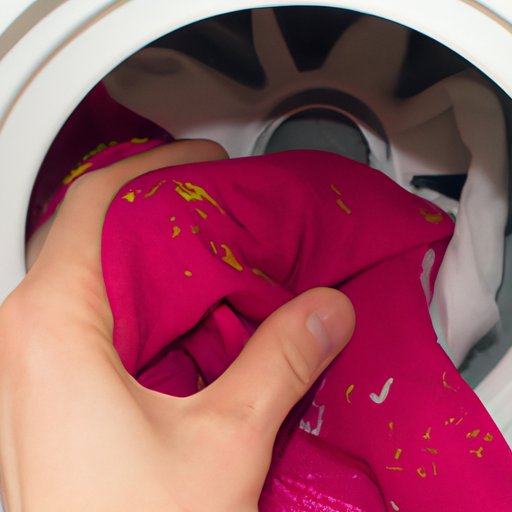Introduction
Clothes shrinkage is a common problem that everyone has experienced at some point. It can be an annoying and costly issue, especially when you have invested in quality clothing. But what exactly causes clothes to shrink and what can you do to prevent it from happening? This article will explore the science behind clothes shrinking in the wash or dryer and provide tips on how to avoid and fix this common problem.

Exploring the Science Behind Clothes Shrinking in the Wash or Dryer
Clothes shrinkage occurs when the fibers in the fabric are exposed to high temperatures and/or moisture. Heat causes the fibers to contract, while moisture makes them swell, which can result in a significant reduction in size. The degree of shrinkage depends on the type of fabric and how it was treated during manufacturing. For example, natural fibers such as cotton, wool, and linen are more prone to shrinking than synthetic materials like polyester and nylon.
It is important to understand how heat and water affect different fabrics in order to avoid shrinkage. When exposed to heat, natural fibers tend to become stiffer and more brittle, while synthetic fibers soften and become less durable. Moisture causes the fibers to expand and become weaker, which can lead to tears, warping, and other damage. Additionally, some fabrics may require special treatments to prevent them from shrinking, such as pre-washing or ironing.

How to Prevent Clothes from Shrinking in the Wash or Dryer
The key to avoiding clothes shrinkage is to follow the instructions on the garment’s care label. Most clothing items will specify the best washing and drying methods for that particular fabric. Be sure to use the correct temperature setting and cycle length for the item in question. Additionally, avoid overloading the washer or dryer and make sure to dry the item thoroughly before storing it away.
The type of fabric is also an important factor in preventing clothes shrinkage. Natural fibers such as cotton, wool, and linen are more susceptible to heat and moisture than synthetic materials. For these fabrics, it is best to avoid hot water and high heat settings when washing and drying. Additionally, some fabrics may need to be pre-washed or ironed before being worn to reduce the risk of shrinkage.
How to Unshrink Clothes After They Have Been Washed or Dried
Unfortunately, even when following the proper care instructions, clothes may still shrink in the wash or dryer. Fortunately, there are steps you can take to restore the item back to its original size. One method is to submerge the shrunken item in lukewarm water and add a few drops of hair conditioner. Gently knead and stretch the fabric until it reaches its original size. Then, lay the item flat on a towel and reshape it before allowing it to air dry.
Another method for unshrinking clothes is to use a steamer. Simply hang the item up and use the steamer to gently steam the fabric until it reaches its original size. You can also try using a blow dryer on a low heat setting. Place the item on a flat surface and use the dryer to slowly warm and stretch the fabric until it reaches its former size.
Conclusion
Clothes shrinkage is a common problem that can be caused by heat, moisture, and improper care. To prevent clothes from shrinking in the wash or dryer, it is important to follow the instructions on the garment’s care label and select the appropriate temperature and cycle length for the fabric. If clothes do shrink, there are steps you can take to restore them back to their original size, such as using a steamer or blow dryer.
No one wants to experience the frustration of having their favorite shirt or pair of jeans shrink in the wash or dryer. By understanding the science behind clothes shrinking and taking the necessary precautions, you can avoid this common problem and ensure your clothing lasts longer.


